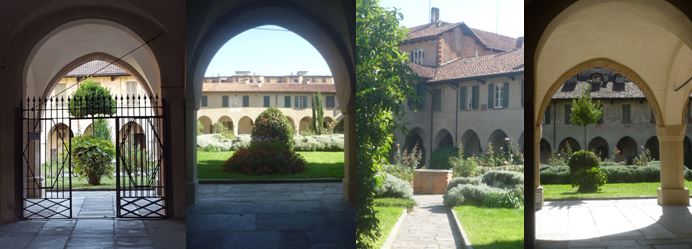Erasmus+ project : Minds on the Move !
Applying Geocaching to Education

This cache is a part of a pedagogic European Erasmus + project called « Geocaching - Minds on the Move ». Pupils and teachers from seven different countries (France, Greece, Italy, Lithuania, Poland, Portugal and Spain) have used Geocaching as an Educational Tool. We hope you’ll enjoy it.
----------------------------------------------

The Canonica
The place is an island of tranquility amid the bustling city centre. Lots of people do not even know about it, but those who do never forget to bring visitors there for a “pit-stop”.
The place is actually the cloister attached to the Cathedral of Santa Maria and it hosts copies of Roman epigraphs, tombstones, and sarcophagi of great archaeological interest. The originals are collected in the Musei della Canonica del Duomo (Cathedral Vicarage Museums), whose entrance is at the north-west corner of the porch.
Very likely under the ground there are remains dating back to the Roman times.
In the Middle Ages the place was the seat of a court of justice; cases were discussed under an elm tree.
In the XVIII and XVIX centuries the courtyard was used as a marketplace, on Mondays, Thursdays and Saturdays.
Before the arrival of the French Republican troops there were doors at both ends of the lane leading to the Vicarage. The French had the doors removed in order to keep the way clear and lined the lane with post-lamps.
The Legend of Celestina
The legend says that in the first half of the 19th century, a blacksmith nicknamed Mazzagat (“Cat Killer”) because of his rather quick-tempered personality, had its own workshop in the Canonica lane. He used to argue with his lover Celestine and one day (not a good one), while quarreling he had a fit of anger and killed her.
Of course he was arrested and sentenced to life imprisonment (and he died in prison). However, the inhabitants of the Canonica lane, and the whole city, were not relieved because since that very bad day the soul of the poor Celestine started haunting the place. Lots of people reported having met the ghost of a black-veiled woman throwing around her evil eyes, predicting very bad luck and certainly causing nightmares to the more sensitive.
To put an end to this period of terror that forced the Novaresi to stay at home after sunset, one day someone put a terracotta statue of a Madonna attached to the wall in front of the entrance of the Mazzagat’s workshop. From then on nobody met Celestina's ghost. Thre is no trace of the workshop today, but the Madonna is still there.
In order to get the HINT, you have to solve the following QUIZ:
https://learningapps.org/watch?v=pix5inhg218
PER TROVARE LA CACHE OCCORRE RISOLVERE IL QUIZ (AL TERMINE DEL QUALE TROVERETE UN PREZIOSO INDIZIO/SUGGERIMENTO):
https://learningapps.org/watch?v=pix5inhg218
----------------------------------------
Il posto è un'isola di tranquillità nel centro della città. Molte persone non sanno nemmeno che esiste, ma quelli che lo conoscono non dimenticano di portare i visitatori lì per una piacevole scoperta.
Il luogo è in realtà il chiostro annesso alla Cattedrale di Santa Maria e ospita copie di epigrafi romane, lapidi e sarcofagi di grande interesse archeologico. Gli originali sono raccolti nei Musei della Canonica del Duomo, il cui ingresso si trova nell'angolo nord-est del portico.
Molto probabilmente sotto terra ci sono resti risalenti all'epoca romana.
Nel Medioevo il posto era la sede di una corte di giustizia; i casi venivano discussi sotto un albero di olmo.
Nei secoli XVIII e XVIX il cortile era utilizzato come mercato, il lunedì, il giovedì e il sabato.
Prima dell'arrivo delle truppe repubblicane francesi c'erano porte alle due estremità del vicolo che conduceva al vicariato. I francesi hanno rimosso le porte per mantenere la via libera e hanno posto dei lampioni lungo il vicolo.
La leggenda di Celestina
La leggenda narra che nella prima metà del XIX secolo, un fabbro soprannominato Mazzagat ("Cat Killer") per la sua personalità piuttosto irascibile, avesse un suo laboratorio nel Vicolo della Canonica. Questi aveva l'abitudine di litigare con tutti, ma in particolare con sua moglie Celestina.
Un giorno (non un buon giorno), mentre litigavano, preso da un attacco di rabbia, Mazzagat uccise Celestina. Naturalmente venne arrestato e condannato all'ergastolo (e morì in prigione).
Tuttavia, gli abitanti del Vicolo e l'intera città non furono sollevati perché da quella brutta giornata l'anima della povera Celestina iniziò a vagare per il Vicolo e a spaventare gli abitanti.
Molte persone iniziarono a riferire di aver incontrato il fantasma di una donna velata di nero che lanciava sguardi malvagi, predicendo sfortuna e sicuramente causando incubi ai più sensibili. Per porre fine a questo periodo di terrore che costringeva i Novaresi a rimanere a casa dopo il tramonto, un giorno qualcuno fece mettere sul muro di fronte all'ingresso della bottega di Mazzagat una statua della Madonna. La cosa funzionò perché da allora in poi nessuno incontrò più il fantasma di Celestina. Oggi non c'è traccia del laboratorio di Mazzagat, ma la Madonna è ancora lì.
----------------------------------------